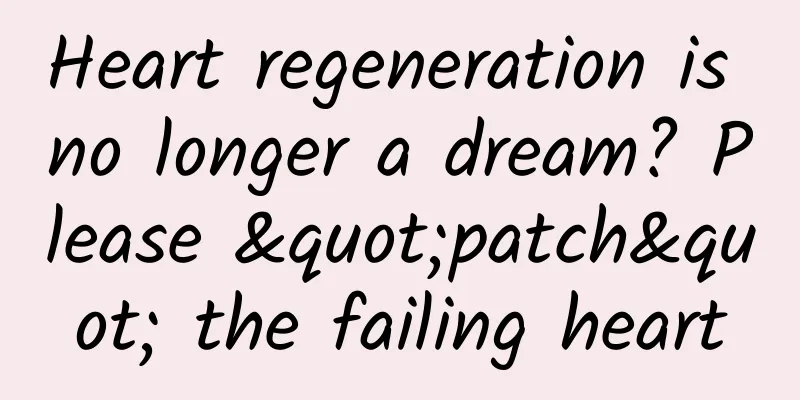Heart regeneration is no longer a dream? Please "patch" the failing heart

|
The heart is one of the most important organs in the human body, and its health status is directly related to human life safety. However, the heart of an adult mammal cannot regenerate. Once the myocardium is damaged, it can only form scars, leading to dysfunction and even heart failure. Heart failure is one of the main causes of death in humans, and there is currently no effective treatment to reverse the progression. Although traditional organ transplantation can provide certain solutions, it is limited by the scarcity of donors and cannot be widely implemented. In order to find new treatment approaches, a German scientific team conducted an innovative study to use stem cell technology to induce the generation of engineered myocardium (EHM) to provide a "patch" for the failing heart in order to repair the damaged heart structure and function, bringing new hope to patients with heart failure. Research methods and process At the beginning of the study, the researchers used induced pluripotent stem cell technology. This technology can reprogram ordinary cells into pluripotent stem cells, which can then differentiate into specific types of cells. In this study, pluripotent stem cells were induced to differentiate into cardiomyocytes and stromal cells with fibroblast characteristics. These cells were then embedded in collagen hydrogels to form EHM patches with spontaneous contraction capabilities. Subsequently, in order to verify the safety and effectiveness of EHM, the researchers conducted an implantation experiment on rhesus monkeys. They selected healthy rhesus monkeys and rhesus monkeys with ischemia/reperfusion injury-induced heart failure as experimental subjects. Under the maintenance of appropriate immunosuppressants, the researchers implanted the EHM patch into the hearts of rhesus monkeys and observed them for up to 6 months. After the initial results of the animal experiment, the researchers further tested the performance of EHM in a patient with heart failure who received a heart transplant. This patient came from the BioVAT-HF Phase 1/2 trial (a clinical trial that the research team is conducting to verify the safety and effectiveness of epicardial EHM implantation to repair the heart). She received an EHM transplant three months before receiving a heart transplant. At the same time, the researchers closely followed up and observed her disease course and various indicators. Research Findings 1. Safety and stability of EHM Animal experiment results showed that the implanted EHM patch could last for more than 6 months in rhesus monkeys without inducing arrhythmia or tumor formation. This result shows that EHM has good safety and stability, laying the foundation for subsequent clinical applications. 2. Improved cardiac function and thickening of the heart wall In the experiment, it was observed that the heart wall of the rhesus monkeys implanted with EHM thickened, and the heart function was significantly improved. This shows that EHM can not only exist stably in the body, but also play a role in repairing damaged myocardium and improving heart function. 3. Functional vascularization and revascularization Magnetic resonance imaging results showed that EHM had significant functional vascularization after transplantation. This is the basis for blood supply reconstruction and also provides the necessary nutrition and oxygen supply to the myocardium. No arrhythmia or tumor occurrence was observed in the experiment, further confirming the safety and effectiveness of EHM. 4. Positive results from preclinical testing The test results in patients with heart failure showed that the course of the patients' disease remained stable after EHM transplantation, with no obvious signs of deterioration. At the same time, various cardiac function indicators were significantly improved, such as cardiac output and ejection fraction. These results provide strong support for the clinical application of EHM. Future Outlook As the BioVAT-HF-DZHK20 clinical trial progresses, we are expected to obtain more data on the safety and effectiveness of EHM in humans. If the trial results continue to show positive signals, EHM may become a revolutionary technology in the treatment of heart failure. Its potential for personalized treatment is even more exciting. In the future, it may be possible to customize the most suitable EHM patch according to the specific situation of each patient, thereby greatly reducing the risk of immune rejection and improving the treatment effect. This study not only brings new hope to patients with heart failure, but also opens a new chapter in the entire field of cardiac regenerative medicine. We can foresee that with the continuous advancement of technology and in-depth research, true heart regeneration may no longer be out of reach. However, with the promotion of technology, social and ethical considerations will gradually become prominent. How to ensure fair distribution of technology, how to properly handle potential risks and side effects, and how to fully obtain and respect patients' informed consent are all issues that need to be seriously considered and resolved in the future. Despite the challenges, the research on stem cell-induced engineered myocardium has undoubtedly opened up a new path for the treatment of heart disease, and we look forward to it bringing health and vitality to more patients in the near future. References: Jebran AF, Seidler T, Tiburcy M, et al.Engineered heart muscle allografts for heart repair in primates and humans[J].Nature (2025). https://doi.org/10.1038/s41586-024-08463-0 |
<<: Every year, 650,000 people die from influenza worldwide, while tuberculosis kills 1.25 million!
>>: DeepSeek's new app! What these post-90s people in Hangzhou did became a hot topic
Recommend
Public account disk says "Swordsman" teaching video
Public account Panmian said "Swordsman"...
The mystery of our nose: Why do we only have one nostril?
We use our noses every day, for breathing, smelli...
A complete guide to selling goods in private domain "welfare groups"
Community is one of the necessary operating metho...
The blue ocean of battlefield-changing somatosensory games emerges
After the Wii motion-sensing game console became ...
How to make a one-yuan dating blind box (making a blind box dating applet)
In the past few days, several people asked me if ...
2019 Social Media Content Trends Report
Recently, GlobalWebIndex (GWI) released the GWI S...
The reshuffle of shared power banks has begun, but it is unlikely to become the next shared bicycle
The rise of the sharing economy has brought in a ...
Methodology for increasing private domain traffic from 0 to 100
I first came into contact with private domains wh...
Unveiling the secrets of karst carbon sinks: the never-ending carbon capture expert
The global karst distribution area is 22 million ...
Electric vehicle fires are not a technical issue, quality control and design are the key
This year, there have been more than 50 fires in ...
Direct-sale e-commerce market trends and product intelligence in May
Which categories are hot-selling in various chann...
Firefox for Android is testing credit card and address autofill features
After switching to Fenix, Mozilla has added most ...
From bloom to withering: Blackberry is a wake-up call for Apple
Apple's recent financial report shows that al...
Programmers, how much programming technology can you really master?
I always see some companies describe their job re...
Lenovo Mobile's dilemma: high inventory and financial constraints
On January 18, 2016, Liu Jun, the former presiden...









